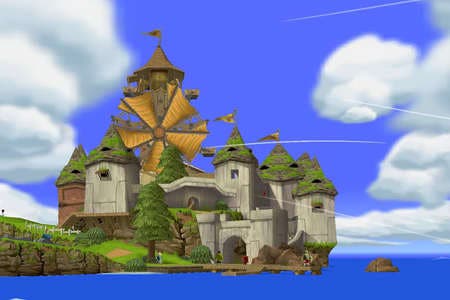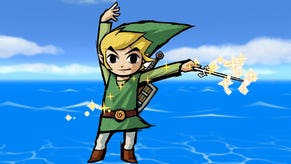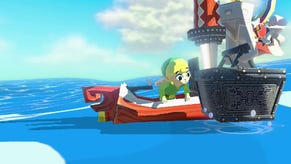Retrospective: The Legend of Zelda: The Wind Waker
"The wind… it is blowing…"
A lot of discussions surrounding the Wind Waker end up preoccupied with the surface of things: with the clear, white-crested waves that smother almost the entirety of the series' beloved landscapes, and with the round-headed, squat-bodied art style that replaces the murkier, more organic visuals of Ocarina of Time or Majora's Mask. Let's duck all of that for a minute, though, and slip beneath the surface: down into the depths of Hyrule's freshly poured oceans, where a chunk of the old world survives, sealed tight inside a neat little bubble.
Down here you'll find the heart of the Wind Waker, if you ask me. It's the setting for the part of the game that is impossible to forget - the part that retains the same mysterious power over you no matter which replay you're on. Far under those shifting seas, and roughly halfway through your latest quest to save the world, you'll discover a monochrome Hyrule Castle, caught in a single, apparently unending moment, preserved right down to its tapestries, flagstone tiles, and that militant, slightly anxious soundtrack from a Link to the Past. Welcome home! Nothing's changed. Nothing at all, in fact - it's actually a little bit creepy.
Visiting this familiar lump of fantasy real estate makes for a strange experience. That's not just because the monsters here are frozen in time, and the sharp, straight-edged architecture is at odds with the craggy dungeons and sandy islands you've been slowly getting used to up on the surface over the last few hours. It's strange because it feels like a glimpse of a game that could have been. Beyond the castle walls, you can spot rounded hills and tidy little clumps of trees. By the time you're outside, the colour has flooded back, too, and you can see an unexpected world of green nested deep within a world of blue.

If you were one of the doubters, put off by the cel-shaded art and the watery landscapes, this is probably the moment that you feel that doubt most keenly. For just the tiniest instant, looking out over the grass and rocks, you might even ask yourself, "Couldn't Nintendo have just made this game? Couldn't they have given me the stuff I already knew I liked instead of all these things I'm not really sure about?"
By then, though, you've retrieved the Master Sword you came for, the ancient, looping legend grinds on a notch, and the castle's returned to hectic, menacing life. The enemies have un-paused themselves, attacked and been defeated, while the Wind Waker tugs you back into the flow of the narrative and up to the surface once more. Deep breath. All gone. Did that really happen? Was it just a dream?
It's a sequence that highlights a conflict going on right at the heart of the Wind Waker. Mechanically, the game can seem a little too similar to Ocarina, offering few genuinely original ideas of its own as you target enemies with a trigger, collect a range of timeworn gadgets and work your way through intricate dungeons. The Wind Waker's positioned so that all the big advances in bringing the series to 3D lay behind it, and the lurid structural experimentations of Majora's Mask are fast receding, too. This instalment isn't about breaking new ground so much as shoring up an already brilliant framework. How exciting can that be?
And yet with its bold art and its striking overworld, it offers a Zelda game of a dizzyingly fresh nature: that steady passage of Hyrulian landmarks has been replaced by a rippling, formless sea, after all, and the mountains, villages, shops and caverns are now reserved for a series of pretty little islands dotted across the map. Is it too ambitious, then, or is it not ambitious enough?
The Wind Waker was probably the first time many people asked this question of a Zelda game. Now, it's an argument that is wheeled out with every instalment. That's because the discussion itself is deeply rooted in the things that make the series what it is. It all comes down, in fact, to the knotty problem of ritual.
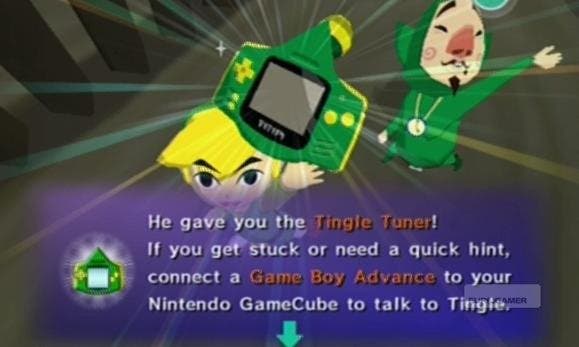
Ritual has always been the most important word with the Zelda series. From one point of view, it's the thing that makes them warmer. It makes them more lovably familiar than any other games, as you kick off each new adventure and immediately spot all the wonderful things that you already recognise, from the same old gear to the same old locations. It's the hookshot! The mountain! Look at all those jars just waiting to be broken!
From another angle, though, ritual's slowly strangling Zelda. The same old gear, the same old locations. Oh God, it's the boomerang. Oh God, it's the fire temple. Zelda, at times, can seem trapped within its brilliance; frozen in place just like Hyrule Castle, a victim of some kind of well meaning but ultimately rather smothering magic.
There is another angle to see things from, though. Over the years, perhaps Zelda's rituals have provided a reliable framework that offers just enough restrictions to force its designers to do something amazing each time around, so as to stop its endlessly repeating narrative from becoming stale. Zelda's increasingly about giving old ideas a smart new twist, in other words, and the best games are therefore the ones with the best twists.
And the Wind Waker's twist, if you ask me, is magnificent. I love the old castles and horseback shtick, but this is a rare chance to see Zelda transposed into an entirely different tradition, to see Tolkien give way to Stevenson as the hero in green settles in with pirates, galleons, and treasure maps.
Link's a mere boy in the Wind Waker - no older, probably, than Jim Hawkins was - and you can feel it, too. After the dark, oppressive clockwork of Majora's Mask, the Wind Waker is suddenly filled with a boyish energy, and a boyish enthusiasm. Mainsails! Seagulls! Tiki masks! There's enough that's familiar, whether you're after yet another chat with the Deku Tree, or more of that glorious trigger-locked targeting, but there's plenty of stuff that's been energetically refined, too.
The combat, with its ascending musical scale, firework flashes of light, and the best hit-pause since Pac-Man. The character designs, from the Moblins who are now a slack-jawed vision of gormless depravity, to the glistening tea-time jelly ChuChus, and the proud, bird-like Rito.
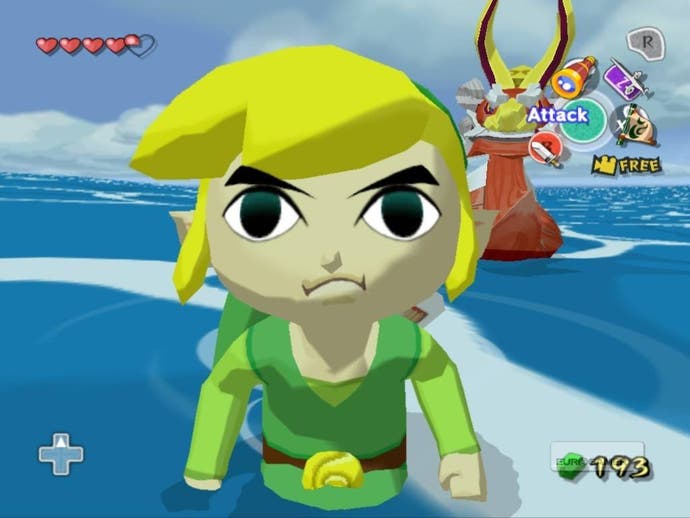
The soundtrack races through plenty of your favourite old tunes, but it's sweeping, dipping, leaping and triumphant. The dungeon designs may not be as devious as before, but they're far more thematically rich, from the coils of magma and blasts of flaming ash that help burn Dragon Roost Cavern into players' memories, to the cathedral of engineering that is the Wind Temple, built around an ancient and gigantic turbine.
Then there's the stuff that really sticks with you. There are spooky grottoes waiting for you beneath some of this shifting water: little dens riddled with sunken galleons begging you to light up their wrecks with fire arrows. There's a pear-type thing that you balance on your head before transferring your soul into a hungry seagull. There's a ghost ship, too, glimpsed on the horizon late at night, flickering with tiny blue flames and winking out of existence just as you approach.
The sea itself, meanwhile, which is often criticised as being featureless and a little bland, turns out to be a masterstroke. The exhilaration you feel when you first loft your sail and the main theme strikes up is every bit the equal to the moment you first leap the fences of Lon Lon Ranch on the back of Epona, while the floating Moblin platforms, menacing octopode, and rickety cannon ships allow for plenty of action as you bounce across the waves.
The Great Sea's an emotional beast, and it dictates the game's mood in a way that Hyrule Field never could. It's blustery when things get bad, and smooth and glimmering when you're on a roll. Each square of the map contains a new island for you to explore, too, whether it's a spindly mountain spewing icy wind into the atmosphere, the roving spotlights and patrolling guards of the Forsaken Fortress, or even just a mysterious abandoned Cabana.
In Windfall, it has one of Zelda's best ever towns, rich with secrets, full of chatty locals standing on winding paths and blessed, of course, with an eccentric Elvis impersonator. In Outset, it has a Hawaiian-styled home-base-cum-tutorial-cum-endless-playground that will simply never be beaten: rocks to hop between, pigs to menace, and granny - poor granny - ailing bravely in her favourite chair. (Her weather-beaten facial features have clearly been etched by the force of so many sympathetic grannyish smiles. When Koji Kondo played her theme at the recent anniversary concert, Eurogamer contributor Chris Schilling burst into tears. Good man.)
And each time you see something new out on the Great Sea - preferably spotted emerging out of the haze, through the lens of your spyglass - your adventure begins afresh. Stow the sail, jump into the frothy water, and then wade ashore, your stumpy little feet leaving tracks in the sand. Zelda's always been a game about sightseeing, but no instalment, before or since, has ever captured this swashbuckling sense of exploration.
There are cuts, of course, and some of them really hurt. At least one dungeon's been snipped away in its entirety, leaving the first act feeling distinctly lop-sided, while the end-game approach is rightly criticised for a shamelessly prolonged treasure hunt that will cost you plenty of time and thousands of rupees.
In truth, the central wind control mechanic, allowing you to direct the Great Sea's wayward breezes with a few swings of your baton, lacks the primal power or sense of occasion you got from the time-shifting Ocarina, too. This was the first Zelda game that didn't feel like it had been held back, bull-headedly, until every part of it sings. Blame the worldly troubles of the GameCube, perhaps. Blame the petty fluctuations in a publisher's fortunes.
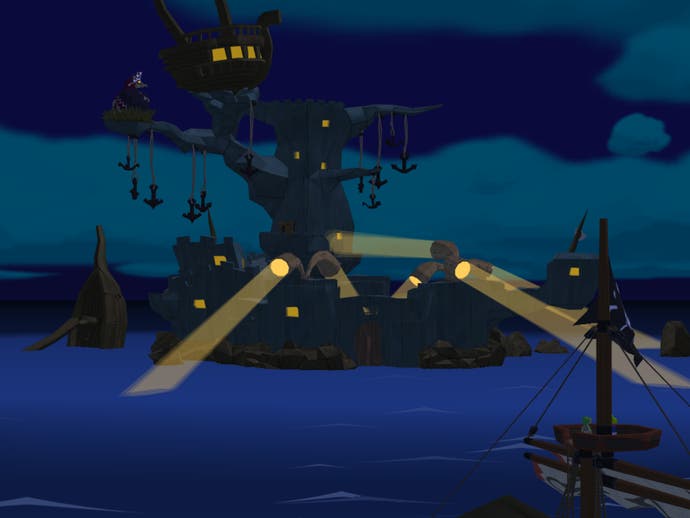
The effort's been spent where it matters, though, with one of the most consistent and imaginative aesthetics of any video game ever made, with a huge skybox that rolls through a wonderful day night cycle that begins with that familiar flute chirruping, with a plucky little craft that skims over the oceans sending out two spouts of water in front of it, and with dungeon design that sees you teaming up to explore certain areas with a partner and then - it's actually surprisingly painful - leaving your new friends behind as custodians just as you feel like you're getting to know them.
Armed with that cartoon art style that will simply never age - and that allows for plenty of flashes of humour, what with Link's unexpectedly grumpy emoticon mouth and those huge, expressive eyes - Nintendo also spins one of its best timeless tales, too, as a kidnapping on a hero's tenth birthday leads to the righting of an ancient wrong and the redemption of a flawed ruler.
It's filled with some of the series' most spectacular moments - towers that rise from the seas, giant birds erupting from toppling fortresses - but it's all powered by some rather dark internal machinery. More than most Zelda games, this is about history creeping back to haunt you, and old men who can't quite let go of the past. "If only I could do things over again," says the weary king in the final act. "I have lived bound to Hyrule."
And yet it ends with the boldest of hopes: Ganon's defeated and Link's triumphant. This stuff is no surprise, of course, but there's more: that strange, unnatural, underwater bubble is shattered, and the old world is washed away completely. "Anchors up! Hold the tiller steady," declares Tetra, after the final credits roll. "As for our destination, the wind will guide us."
Perhaps the Wind Waker's developers felt a twinge of that same freedom, too, having drowned the magical but quietly crippling Zelda framework and cut themselves loose to build something unexpected and unprecedented. Maybe that comfortable age-old cycle of cleverly reworking the past with each instalment could finally draw to a graceful conclusion, and the series could genuinely start things over.
Sadly, it was not to pass. Twilight Princess followed, and although it was a treat to see Epona again, the whole thing bore the faintest tint of surrender, of retraction. Hyrule endured, and Link was back exploring a safe, familiar world of woodland and mountains and vast, stony castles.
When they unveiled Twilight Princess at E3 2004, fans whooped and cheered, and the sound was deafening. Maybe, in the end, it was the Great Sea itself that was actually just a dream.
